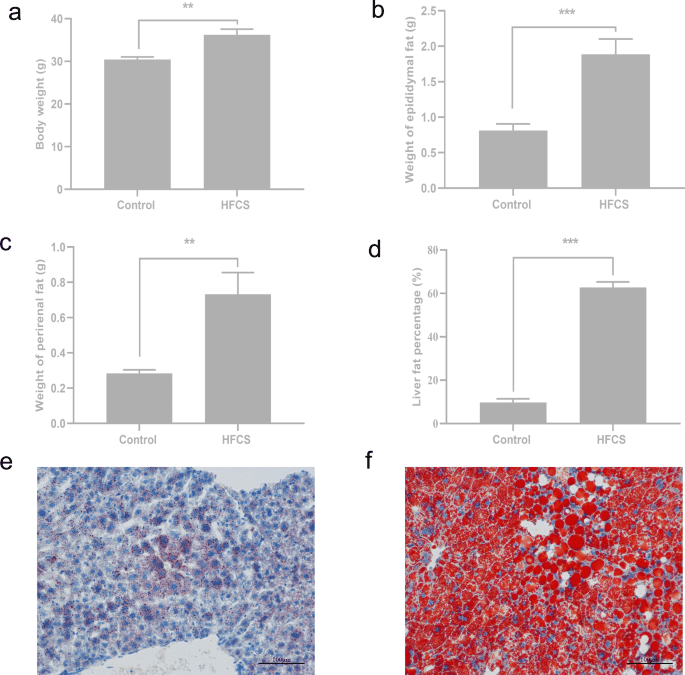Effects of HFCS on intestinal microbiota structure and obesity in mice
In this study, the long-term intake of drinking water containing 30% HFCS caused significant increases in body weight, perirenal fat, epididymal fat (P = 0.001, P = 0.0009, P = 0.007, respectively), and liver fat percentage in mice (P < 0.0001), as shown by a considerable increase in the proportion of area occupied by positively stained lipid droplets (Fig. 1). Further, high-throughput sequencing revealed the occurrence of significant changes in the colonic microbiota. The community richness of colonic microbiota in the HFCS group was significantly decreased compared with that of the control group (Supplementary Table 1). Beta-diversity analysis revealed the presence of significantly different clusters between the two groups (Supplementary Fig. 1). At the phylum level, the taxonomic distribution of the colonic microbial communities in both groups displayed that Firmicutes, Bacteroidetes, Proteobacteria, Actinobacteria, Tenericutes, and Deferribacteres were (Supplementary Fig. 2a) the dominant bacteria, which accounted for more than 99.29% of the colonic microbiota. Changes in colonic microbiota composition at the genus level were also observed (Supplementary Fig. 2b). In both groups, the top 10 genera with the highest relative abundances were Erysipelotrichaceae_uncultured, Bacteroidales S24-7 group_norank, Allobaculum, Faecalibaculum, Staphylococcus, Lactobacillus, Bacteroides, Lachnospiraceae_uncultured, Turicibacter, and Lachnospiraceae NK4A136. The bacteria with higher relative abundance and significant difference between the two groups were screened and plotted on a heat map (Fig. 2). This indicates that the intake of HFCS-containing drinking water resulted in considerable changes in the colonic microbiota structure of mice.Correlations between microbial genera and obesity indices
From the 42 genera with significant differences in relative abundance between the two groups, the obesity-associated genera Christensenellaceae R-7 groupand Tyzzerella, as well as the pathogenic bacteria Erysipelatoclostridium and Helicobacter, were selected to analyze their correlations with phenotypic variables of body weight, perirenal fat, epididymal fat, and liver fat percentage (Supplementary Fig. 3). We found that Tyzzerella, Erysipelatoclostridium, and Helicobacter were positively correlated with body weight, perirenal fat, epididymal fat, and liver fat percentage, whereas Christensenellaceae R-7 group was strongly negatively correlated. The genus Tyzzerella of the family Lachnospiraceae showed a significant increase in abundance after intervention with HFCS-containing drinking water. At the genus level, the relative abundances of conditional pathogenic bacteria, such as Erysipelatoclostridium and Helicobacter, were significantly increased in the HFCS group compared with those in the control group.HFCS may induce obesity by affecting Christensenellaceae R-7 group in intestinal flora
The increase in body weight and visceral fat was consistent with previous studies9,10. The accumulation of visceral fat leads to a higher tendency of insulin resistance, disorders in sugar utilization, and increased lipolysis, which are key factors for the onset of metabolic syndrome. Therefore, the measurement and analysis of body weight, visceral fat content, and peripheral fat content are of great importance11. Wostmann et al. found that the increase in body weight of mice in a germ-free environment was slower than that of normal mice, which demonstrates the beneficial effects of microbial communities on fat deposition12. Other researchers have also directly demonstrated the relationships between microbiota and metabolic disorders, such as obesity13. In mice on a high-fat diet and obese individuals reportedly have higher abundances of Firmicutes and Bacteroidetes in the body, forming an obesity-type intestinal microbiota14, but other studies have reported that a high-fat diet reduces the ratio of Firmicutes to Bacteroidetes and the abundances of intestinal microbes15. The results of the present study might be attributed to the fact that mice of the HFCS group were only provided HFCS-containing drinking water and basal feed without the addition of high-fat feed. Firmicutes are capable of utilizing carbohydrates in food for the synthesis of butyrate, which serves as an energy source and maintains epithelial cell morphology and normal function in the colon16. Pediatric researchers at the University of Alberta in Canada found that Lachnospiraceae species feed on undigested carbohydrate fibers in the human body, thereby contributing additional calories through carbohydrate degradation and resulting in obesity13. Christensenellaceae, a member of the phylum Firmicutes, is abundant in the colons of humans and animals and accounts for 0.01% of the fecal microbial communities17. Christensenellaceae are also closely associated with host health as their relative abundance is associated with the onset of colorectal cancer and inflammatory bowel disease18,19,20,21. Further, the relative abundance of this family in the intestines is associated with body mass index, a direct indicator of obesity, in the populations of many countries, which includes adult men and women of different age groups17. The existence of a negative correlation between Christensenellaceae and the amount of visceral fat has also been reported22. Metabolic disorders are usually related to dietary patterns, with research evidence indicating that Christensenellaceae R-7 group is decreased in populations on a refined sugar diet23. Such evidence is consistent with the results of the present study, which showed that long-term high-dose HFCS consumption led to a decrease in Christensenellaceae R-7 group, thereby inducing obesity or even the inflammatory response in mice. These results are consistent with those reported by Beaumont et al17,22. and demonstrate that the relative abundance of Christensenellaceae R-7 group is negatively correlated with body weight and visceral fat content. Therefore, it can be deduced that HFCS intake induces obesity in mice by regulating the relative abundance of the genus Christensenellaceae R-7 group.The results of this study provide theoretical support for the rational use of sweeteners, suggesting that HFCS may induce obesity by affecting Christensenellaceae R-7 group in intestinal flora. However, the specific mechanism is still unclear, which will be further studied in the follow-up study.

Effects of high fructose corn syrup on intestinal microbiota structure and obesity in mice - npj Science of Food
High fructose corn syrup (HFCS)-associated health problems have raised concerns. We investigated the effects of HFCS-containing drinking water on body fat, intestinal microbiota structure of mice, and the relationships between them. HFCS drinking water significantly increased body fat content...
